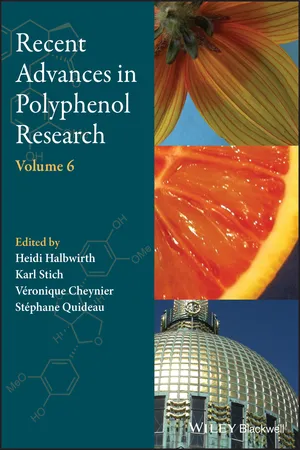
Recent Advances in Polyphenol Research, Volume 6
- English
- ePUB (mobile friendly)
- Available on iOS & Android
Recent Advances in Polyphenol Research, Volume 6
About This Book
Plantpolyphenols are secondary metabolites that constitute one of the most common and widespread groups of natural products. They are crucial constituents of a large and diverse range of biological functions and processes, and provide many benefits to both plants and humans. Manypolyphenols, from their structurally simplest representatives to their oligo/polymeric versions, are notably known as phytoestrogens, plant pigments, potent antioxidants, and protein interacting agents.
This sixth volume of the highly regarded Recent Advances inPolyphenol Research series is edited by Heidi Halbwirth, Karl Stich, Véronique Cheynier and Stéphane Quideau, and is a continuance of the series' tradition of compiling a cornucopia of cutting-edge chapters, written by some of the leading experts in their respective fields of polyphenol sciences. Highlighted herein are some of the most recent and pertinent developments in polyphenol research, covering such major areas as:
- Chemistry and physicochemistry
- Biosynthesis, genetics & metabolic engineering
- Roles in plants and ecosystems
- Food, nutrition & health
- Applied polyphenols
This book is a distillation of the most current information, and as such, will surely prove an invaluable source for chemists, biochemists, plant scientists, pharmacognosists and pharmacologists, biologists, ecologists, food scientists and nutritionists.
Frequently asked questions
Information
1
The Lignans: A Family of Biologically Active Polyphenolic Secondary Metabolites
1.1 Introduction


1.2 Biosynthesis of Lignans
Table of contents
- Cover
- Table of Contents
- Contributors
- Preface
- Acknowledgements
- 1 The Lignans: A Family of Biologically Active Polyphenolic Secondary Metabolites
- 2 Anthocyanin Accumulation is Controlled by Layers of Repression
- 3 The Subtleties of Subcellular Distribution: Pointing the Way to Underexplored Functions for Flavonoid Enzymes and EndProducts
- 4 Transcriptional and Metabolite Profiling Analyses Uncover Novel Genes Essential for Polyphenol Accumulation
- 5 Dietary (Poly)Phenols and Vascular Health
- 6 Cellular‐Specific Detection of Polyphenolic Compounds by NMR‐and MS‐Based Techniques: Application to the Representative Polycyclic Aromatics of Members of the Hypericaceae, the Musaceae and the Haemodoraceae
- 7 Metabolomics Strategies for the Dereplication of Polyphenols and Other Metabolites in Complex Natural Extracts
- 8 Polyphenols from Plant Roots: An Expanding Biological Frontier
- 9 Biosynthesis of Polyphenols in Recombinant Micro‐organisms: A Path to Sustainability
- 10 Revisiting Wine Polyphenols Chemistry in Relation to Their Sensory Characteristics
- 11 Advances in Bio‐based Thermosetting Polymers
- 12 Understanding the Misunderstood: Products and Mechanisms of the Degradation of Curcumin
- 13 How to Model a Metabolon: Theoretical Strategies
- Index
- End User License Agreement